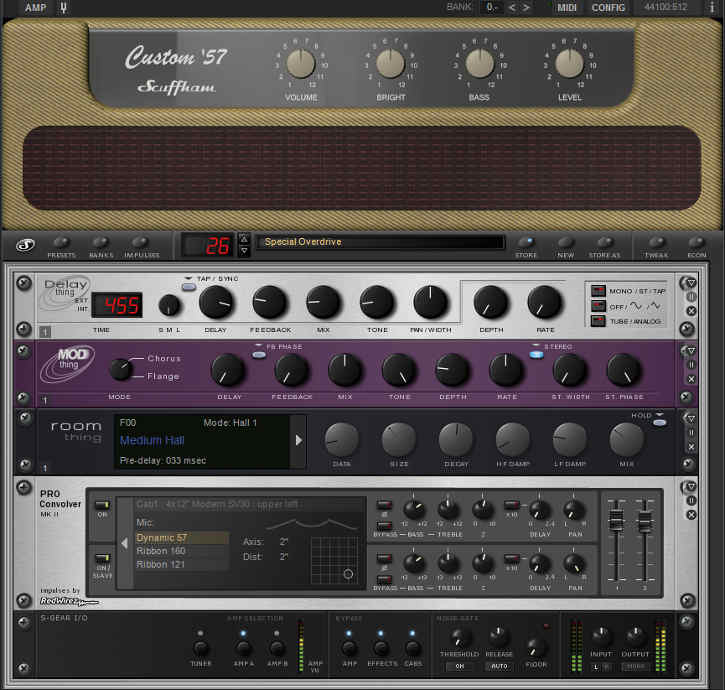S-Gear has a lot of devoted fans. But what makes it special?
I reviewed S-Gear 1.0 when it first came out, and couldn’t understand why I wasn’t getting good sounds out of it. Frankly, I think the designer was upset with me because he kept telling me it was fine, and I kept telling him there was a problem. Eventually, I found what the issue was: S-Gear’s meters weren’t fast enough to register the transients, so I was feeding in too much level, which was causing unintended (and nasty!) distortion. To be fair, I don’t think that was S-Gear’s fault, but the fault of computers from several years ago that just couldn’t handle updating graphics fast enough.
Well, now I have a faster computer. And S-Gear 2.7.
It’s great.

Now, like all amp sims, it’s not for everyone. S-Gear doesn’t dazzle with additional effects; there’s a delay, a room sound/reverb, and modulation (and yes, they’re all good). No compressors, no auto-wahs, no ring modulators. That’s okay. You can add up to two of each effect, and re-arrange them in a modular virtual rack. The Pro Convolver module loads a variety of impulses (included), with various mics and positions. However, what’s notable here is you don’t adjust the mic and position to try and get a good sound. The sound will already be good—but there’s always the chance you can find a better one.
THE PRESETS ARE ACTUALLY GOOD…
In fact, this is one of the few amp sims where I’d say you can judge it by the presets. By and large they’re at least useful, and at best, inspiring. S-Gear used to have the rep of not being able to do high-gain, but I’m not totally convinced..I was able to dial up some solid metal tones. With several presets, I did prefer to dial back the Gain a bit. However, do remember I play 0.010s with a thumb pick, so there’s a lot of level emanating from the guitar.
My main collaborator, Brian Hardgroove from Public Enemy, is a hardcore S-Gear fan. I can see why. There’s an authenticity to the sound that provides a musical, general sonic palette. Also, I didn’t find myself reaching immediately for a parametric EQ to insert at the output. Instead, I dialed up preset after preset, and kept being greeted with organic-sounding guitar amps.
WHAT S-GEAR DOES BEST
S-Gear 2 reminds me conceptually of the PRS SuperModels. They also have an authentic feel, and aim to do a limited number of sounds really well instead of trying to be all things to all people. Interestingly, I wasn’t quite as enamored of S-Gear 2’s clean sounds as the crunchy sounds, but that may be because the crunchy sounds are so good. This isn’t a diss on the clean sounds; they’re fine. It’s more like when you go to a restaurant and you like all the entrees, but you have a favorite.
With S-Gear 2, for me it’s the overdriven, crunchy sounds. They’re remarkably free of atonal components, have a certain smoothness that other amp sims often lack, and don’t demand additional processing. Also, although I like all the amps for various reasons, the Custom ’57 is “tweedier” for me than most tweed models.
This is going to be a short review, because you can download a free 15-day trial. Note that S-Gear 2 also works stand-alone as well as VST, AU, and AAX. I suspect that quite a few guitar players will reach for the credit card within five minutes after flipping through the presets. Others will want more, and that’s okay too. But the bottom line is that Mike Scuffham has created amp sims with an organic, playable, responsive sound.
I’d write more, but I’m having too much fun playing! I’d say the main strength here is vintage sounds, vintage tone, and an authentic vibe. Sure, S-Gear 2 can do more. But for these sounds, S-Gear 2 excels.
